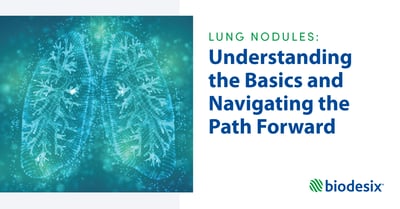How Nodify XL2 Helps Relieve Patient Anxiety [Video]
Nodify XL2™ testing is designed to help physicians identify likely benign lung nodules using a simple to use blood-based test for patients with low to moderate risk incidental lung nodules. Dr. Susan Garwood, M.D., Pulmonary and Advanced Bronchoscopy Lung Cancer Specialist with Centennial Medical Center in Nashville, part of the HCA TriStar division and Tresia Michael, LPN, Lung Nodule Coordinator for Tri-Star Health discuss how the Nodify XL2 test is relieving patient anxiety in their lung nodule clinic.
View the second video, How Nodule Clinics Use a Blood-Based Test to Help Identify Benign Lung Nodules.
Video Transcript:
Dr. Garwood: I think a lot of our time spent in nodule clinic is trying to really assess the risk, and patients want real prognostic information. They want to know how is this going to affect me? How is this going to affect my spouse, my kids, my time off work? There are so many areas of anxiety that go into the thought of the potential of having a cancer. And it doesn't matter how big that spot is, the spot may be four millimeters and it could cause the same anxiety of something that's 10 times as large. So it really is a very personal discussion with each of these. And the more information we can give the patients, the better.
Dr. Garwood: Before Nodify XL2, we had some really difficult times in clinic. When patients would come that, really, we knew looked low risk based on our calculator, sometimes it wasn't enough. We had one patient in particular who went to four different hospitals and had over 10 scans in a short period of time because of his intense anxiety thinking that he might have cancer. He even asked us that day, "Isn't there anything more that you can do? Can't you test my blood and tell if I'm at risk for lung cancer?" Before Nodify XL2, I had to tell him no. Now, we can confidently, even if I know clinically they're low risk, to add something as complex as this to the equation to be able to come up with a clear[er] answer for these patients really can be life changing. Specifically for this man who I'm not sure slept that whole month.
Tresia: I don't think he did and this test, I wish that this test would have been around with him because it [may have given] him peace of mind.
Dr. Garwood: I think the confidence that it gives, not only in my clinical decision making, but they know that we've done everything that's at our disposal, to have the cutting edge science that this adds really is very impactful to our patients.
Tresia: We use the Mayo clinic nodule calculator and put in their age, they have to be over 40, the size of their nodule, which would be eight to 30 millimeters, if it's the upper lobe or lower lobe. That would be one of the calculations as well. And if you're a smoker and then that'll give us our calculation and when we talk to our patients about this additional testing, they're very excited about it honestly. Because if you have a patient who comes in and you tell them that, Oh well we're going to do a six months CT follow-up, well sometimes that doesn't lie well with them. They still have anxiety like, Oh my gosh, I don't know. I don't know if I could wait six months. So I think with us doing the additional testing, it's an extra layer of security for the patient and helps remove some of the anxieties.
Dr. Garwood: I think the movement in this particular field has been so slow over decades. Lung cancer survival rates have not changed more than a percentage point in four decades. It's because we don't have the right tools to tell us who we should and who we should not intervene upon and patients are afraid. Specifically if we're asking them to undergo an invasive procedure, patients can often shy away from that. The fact that I have a blood test that can competently let my patient know that we're making the right decision by them, I think it's going to make a huge impact on the number of true lung cancers we get into the operating room for surgical cure.
Dr. Garwood: I think that one of the most common questions that we get is, is there anything more, doctor? And pet scans are one of the things that are in the guidelines, but it's an expensive test and it's also not a perfectly sensitive test. Things also have to be quite large for a pet to be very accurate and patients are always asking is there another way? And so to be able to offer them something finally that can help really risk stratify them has given our patients a ton of peace of mind.
Topics: lung nodule, video



